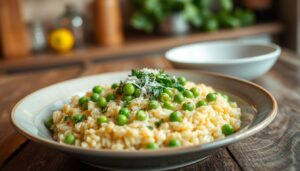Ever thought about turning simple potatoes into a dish that makes your taste buds sing? The potato latkes recipe is your key to making fried potato pancakes. They celebrate traditional Jewish cuisine and satisfy your comfort food cravings.
These golden, crispy treats are more than just a holiday dish. They’re perfect for Hanukkah or a tasty breakfast. Potato latkes bring joy to everyone, crossing cultural lines.
With just 30 minutes of prep and cooking, you can make latkes that wow everyone. Imagine a plate of crispy, yet tender, fried potato pancakes. It’s a treat that will impress your family and friends.
Key Takeaways
- Potato latkes are versatile fried potato pancakes suitable for multiple occasions
- Total preparation time is approximately 30 minutes
- The recipe yields about 16 medium or 32 silver-dollar latkes
- Yukon Gold potatoes work best for authentic texture
- Serving with traditional accompaniments like applesauce enhances the experience
The History and Cultural Significance of Potato Latkes
Potato latkes are more than just a holiday dish. They have a deep history in Jewish culture. Their journey from Eastern Europe to today’s tables is filled with survival, adaptation, and tasty innovation.
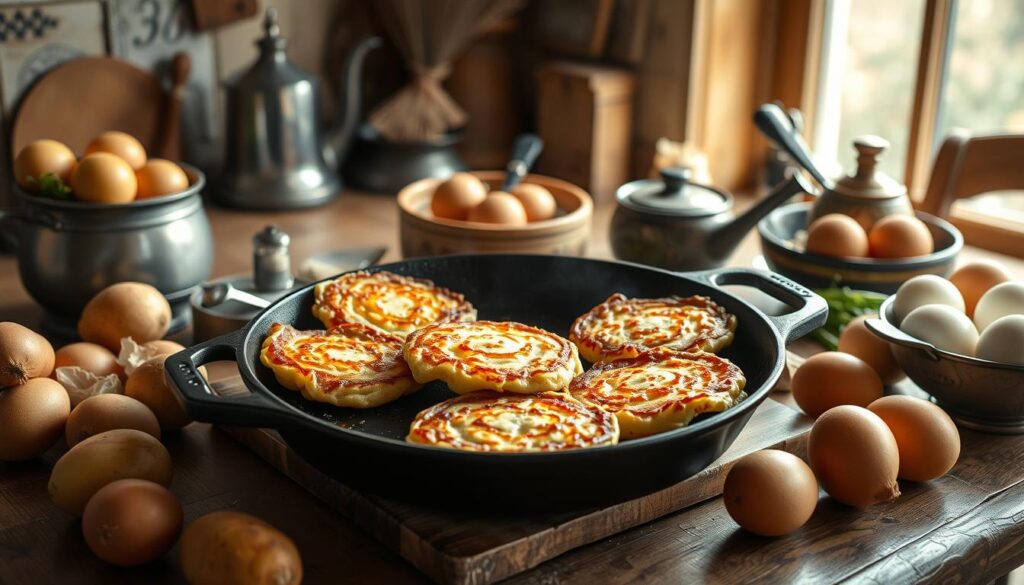
The story of latkes goes back centuries. Potatoes changed latkes in the mid-1800s when they became common in Eastern Europe. Interestingly, potatoes helped Europe’s population grow by 25% between 1700 and 1900, changing local foods.
Traditional Jewish Holiday Connection
Latkes are key during Hanukkah, celebrating the miracle of oil. They remember the oil that lasted eight days, making fried foods like latkes a tradition.
Evolution of Latkes Through Generations
- Original latkes were made with cheese before potato versions emerged
- Immigration to America in early 20th century introduced new cooking methods
- Cooking oil transitioned from schmaltz to vegetable oil
- Regional variations developed unique preparation techniques
Cultural Impact on Modern Cuisine
Latkes have grown beyond their roots, becoming a favorite dish globally. They bring families together, from home to fancy restaurants, through shared meals.
“Latkes are more than food—they’re a delicious piece of cultural history.”
Essential Ingredients for Perfect Potato Latkes
To make delicious potato latkes, you need the right ingredients and preparation. The key is to pick the best parts to turn shredded potatoes into crispy, golden treats.
Selecting the Best Potatoes
Russet potatoes are the top choice for latkes. They have a lot of starch, which helps your pancakes stay together. Look for firm, even russets for the best texture.
- High-starch russet potatoes
- Firm and uniform potato selection
- Freshly peeled and grated
Supporting Ingredients and Alternatives
Latke recipes shine with the right supporting ingredients. Onions add flavor, and matzo meal helps them stick together. For dietary needs, you can swap these:
| Ingredient | Traditional Option | Alternative |
|---|---|---|
| Binder | Matzo meal | Gluten-free breadcrumbs |
| Liquid | Eggs | Flax egg substitute |
Choosing the Right Frying Oil
The oil you use makes a big difference in latke taste and crispiness. Chefs suggest mixing vegetable oil with a bit of schmaltz for real flavor. The best oil heats up to 350-375°F for that perfect golden color.
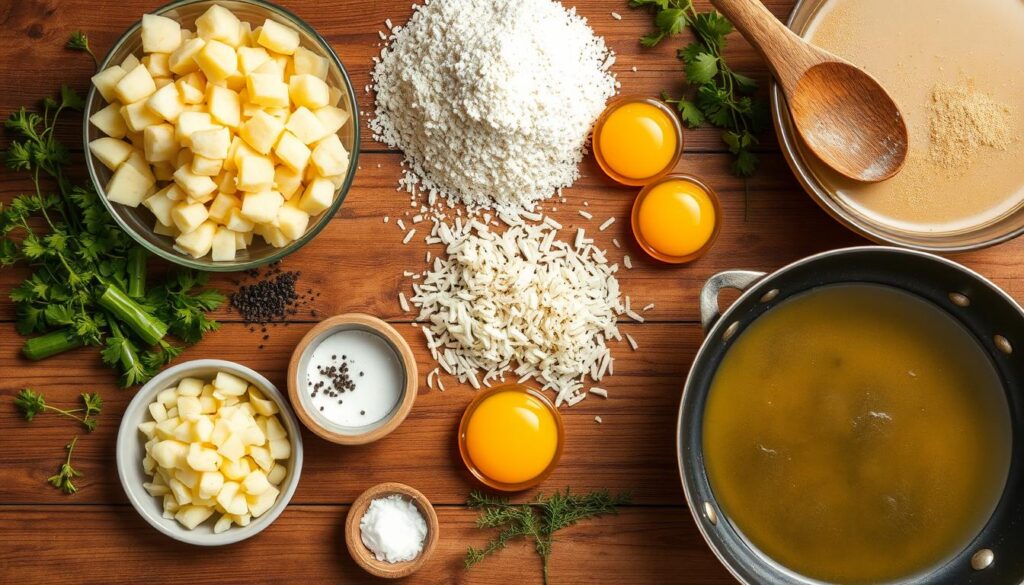
“The secret to great latkes lies not just in the recipe, but in the quality of ingredients you choose.” – Traditional Jewish Cooking Wisdom
It’s important to get rid of extra moisture from your potatoes and onions. Use a clean towel to squeeze out the liquid. This helps your latkes get that crispy outside.
Kitchen Tools and Equipment Needed
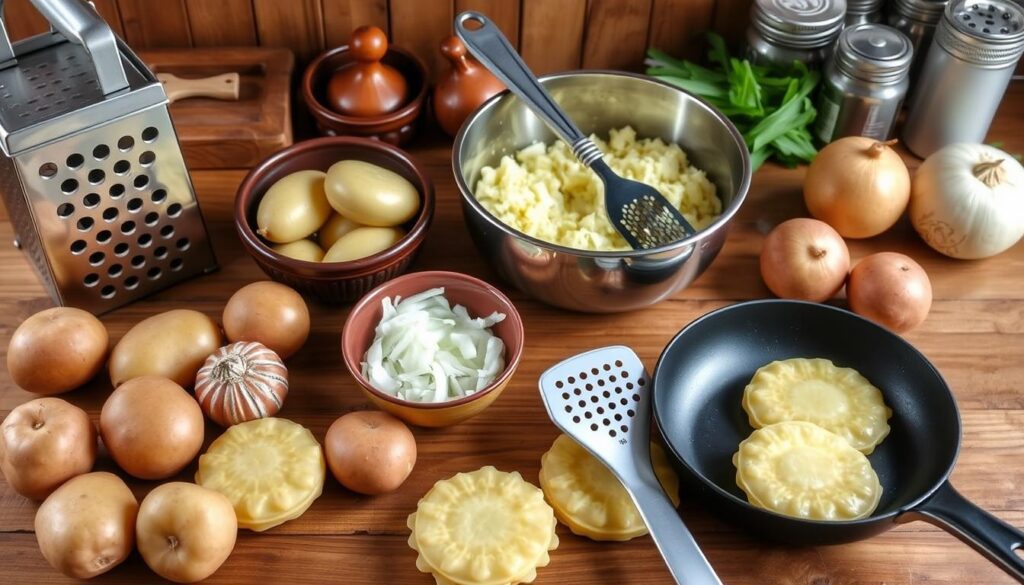
Making delicious potato latkes needs some key kitchen tools. Whether you’re experienced or new, the right tools make frying potatoes fun and easy.
Essential Equipment Checklist
- Food Processor or Hand Grater: Both are great for shredding potatoes
- Large mixing bowls
- Cheesecloth or clean kitchen towel
- 10-12 inch cast iron skillet
- Measuring cups and spoons
- Spatula for flipping
- Paper towels for draining
Shredding potatoes can be done two ways. A food processor makes uniform threads fast. A hand grater adds a personal touch to your cooking.
“The right tools transform cooking from a chore into a delightful experience.” – Culinary Wisdom
Recommended Kitchen Tools for Perfect Latkes
| Tool | Purpose | Recommended Type |
|---|---|---|
| Skillet | Frying latkes | Cast iron (10-12 inches) |
| Moisture Extractor | Removing potato liquid | Cheesecloth or kitchen towel |
| Shredding Tool | Preparing potatoes | Food processor or hand grater |
For crispy latkes, keep your tools clean and dry. A clean kitchen is key to perfect latkes!
Potato Latkes Recipe: Step-by-Step Instructions
Making perfect shredded potato fritters needs precision and care. Your journey starts with knowing the key techniques. These turn simple ingredients into crispy, golden treats.
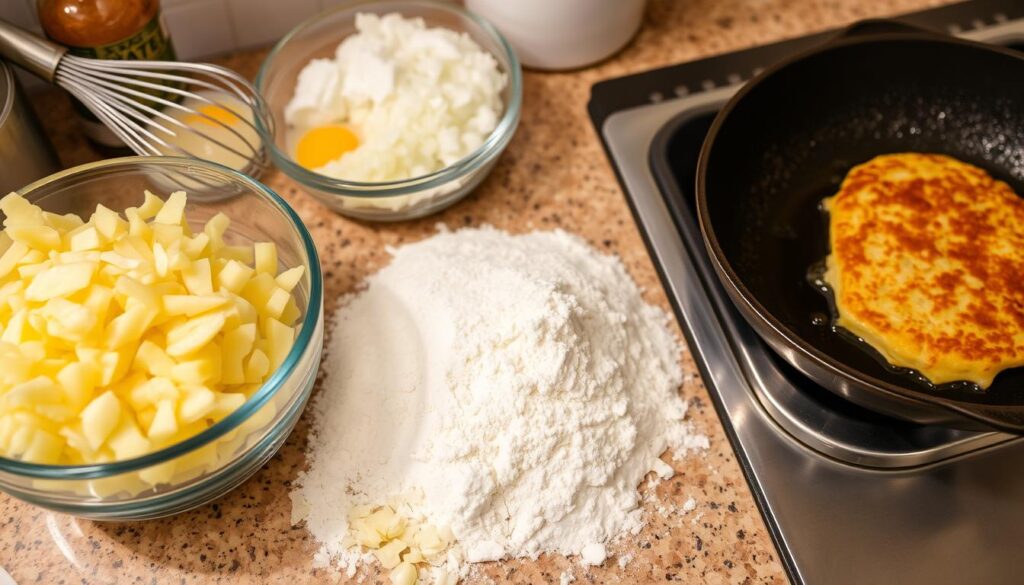
First, get your ingredients and tools ready. Russet potatoes are best for crispy latkes with a soft inside. You’ll need 1½ pounds of potatoes, which is about 3-4 medium-sized ones.
Preparation Phase
Begin by peeling your potatoes carefully. Use a fine-hole cheese grater or food processor attachment for thin, even shreds. Grating techniques are key for the right texture.
- Peel potatoes completely
- Use fine-hole grater
- Aim for thin, consistent shreds
Mixing and Forming
After shredding, remove excess moisture for crispy latkes. Squeeze the shreds in a clean kitchen towel to get rid of about 1 cup of liquid. Then, add finely chopped onions, eggs, and a bit of kosher salt to hold the mixture together.
Cooking Technique
Heat ¼ cup of oil in a heavy skillet at medium heat. Make small patties from your potato mix and fry them in the hot oil. Fry each side for about 3 minutes until they’re golden brown and crispy.
“The secret to perfect latkes is in the moisture control and frying temperature.” – Culinary Experts
Pro tip: Keep the oil at 375°F for the best crispiness. Each batch takes about 6 minutes, making delicious shredded potato fritters that are crispy outside and soft inside.
The Secret to Crispy Exteriors and Tender Interiors
Making perfect crispy potato pancakes is more than just mixing ingredients. It’s about the details in preparation and cooking. With a few tricks, your vegetarian latkes can go from good to great.
Oil is key for a crispy exterior. Use about 1/4 inch of oil in a heavy skillet, like cast iron. The secret to crispy potato pancakes is keeping the oil at the right temperature.
- Heat oil to medium-high (around 350°F)
- Ensure oil sizzles when batter is added
- Use neutral oils like grapeseed or sunflower for best results
Managing moisture is crucial for crispy latkes. After grating potatoes, squeeze out as much liquid as you can. This helps prevent soggy pancakes and ensures a crispy exterior.
Pro tip: A whole trimmed carrot in the oil helps regulate temperature and keeps the oil cleaner during frying.
The perfect latke size is about 3 inches in diameter and 1/2 inch thick. Press down gently while frying to increase crispiness. Cook each side for 3-4 minutes until they’re golden brown.
Remember, practice makes perfect. Your first batch might not be perfect, but with these tips, you’ll soon be making crispy potato pancakes that wow everyone.
Common Mistakes to Avoid When Making Latkes
Making shredded potato patties for Hanukkah can be tricky. Even experienced cooks face challenges. Knowing common mistakes helps make perfect latkes every time.
Temperature control and moisture management are key. These factors can make or break your latkes. Let’s look at common mistakes and how to avoid them.
Oil Temperature Challenges
Getting the oil temperature right is crucial for crispy latkes. Here are signs of oil temperature problems:
- If oil jumps wildly or smokes, it’s too hot
- Weak bubbling means the oil is not hot enough
- The ideal frying temperature is 375 degrees Fahrenheit
Moisture Management Strategies
Too much moisture can ruin your latkes. To avoid soggy latkes, follow these tips:
- Squeeze out excess liquid after grating potatoes
- Use a clean kitchen towel to remove more moisture
- Drain starchy liquid but keep some for better texture
| Mistake | Solution |
|---|---|
| Overcrowded pan | Space latkes to prevent steaming |
| Incorrect oil type | Use canola or corn oil with high smoke point |
| Premature flipping | Wait until golden brown before turning |
Keep practicing and experimenting. For more tips, check out these helpful cooking tips to improve your latke-making skills.
Traditional and Modern Serving Suggestions
Potato latkes are a delightful holiday treat. They shine with the right toppings. Your Hanukkah fritters are a canvas for culinary creativity!
Traditional toppings include applesauce and sour cream. These toppings offer a sweet and tangy flavor. They perfectly complement the crispy potato pancake.
“The magic of latkes lies not just in their preparation, but in how they’re served!” – Traditional Jewish Cooking Wisdom
- Classic Toppings:
- Sour cream
- Homemade applesauce
- Kosher salt
- Modern Gourmet Options:
- Smoked salmon
- Crème fraîche
- Caviar
- Herb-infused oils
Elevate your latkes with unexpected pairings. Try them with creative side dishes. These pairings can turn simple fritters into a sophisticated dish.
| Pairing Category | Recommended Accompaniments |
|---|---|
| Dairy Toppings | Sour cream, Greek yogurt, crème fraîche |
| Savory Additions | Smoked salmon, caviar, chopped chives |
| Sweet Options | Homemade applesauce, fruit compotes |
Pro tip: Serve your latkes immediately after cooking. This keeps their crispy texture irresistible!
Make-Ahead Tips and Storage Guidelines
Planning ahead for your holiday side dishes can make cooking easier and less stressful. Potato latkes are perfect for preparing in advance. This way, you can enjoy these delicious vegetarian recipes with minimal last-minute work.
Proper Storage Methods
After preparing your latkes, you have several storage options to maintain their crispy texture. Here are some key strategies:
- Keep freshly made latkes warm in the oven at 200°F (95°C) on a cooling rack
- Avoid stacking or covering latkes to preserve crispiness
- Refrigerate cooled latkes in an airtight container for 3-4 days
- Freeze latkes for up to 2 weeks for extended storage
Reheating Techniques
Bringing your stored latkes back to life requires careful reheating. For the best results, use these methods:
- Preheat oven to 375°F (190°C)
- Place latkes on a baking sheet in a single layer
- Heat for 10 minutes (7 minutes in a convection oven)
- Flip halfway through to ensure even heating
“The key to perfect reheated latkes is maintaining their original crispy texture and warmth.”
By following these storage and reheating tips, you can enjoy delicious latkes anytime. They make a versatile addition to your holiday side dishes repertoire.
Variations on Classic Potato Latkes
Exploring vegetarian latkes opens up a world of culinary creativity. It transforms the classic potato pancake into an exciting easy appetizer recipe. You can reimagine this traditional dish with endless possibilities.
Professional chefs have been pushing the boundaries of traditional latke recipes. Consider these innovative approaches:
- Sweet potato latkes with a crispy exterior
- Zucchini and carrot fusion latkes
- Apple-cheddar latkes for a unique flavor profile
- Herb-infused vegetarian latkes
The vegan sweet potato burger trend has inspired creative vegetarian latke alternatives. These keep the classic crispy texture while introducing exciting new ingredients.
“Latkes are a canvas for culinary imagination – don’t be afraid to experiment!”
When creating your variations, keep these tips in mind:
- Choose high-starch potatoes for optimal crispiness
- Experiment with different vegetable combinations
- Add unique spices and herbs for depth of flavor
- Consider alternative binding agents for vegetarian options
Your latkes can become an impressive easy appetizer recipe that surprises and delights guests. Whether you’re crafting a traditional version or exploring innovative twists, the key is maintaining that perfect balance of crispy exterior and tender interior.
Nutritional Information and Dietary Considerations
Potato latkes are tasty holiday side dishes that fit many diets. They keep their classic taste. Knowing their nutritional profile helps you choose wisely in this traditional vegetarian recipe.
- Calories per latke: 78 kcal
- Carbohydrates: 8g
- Protein: 1g
- Total fat: 5g
- Dietary fiber: 1g
Nutrient Highlights: Potato latkes are not just tasty. They also have some good nutrients. They have potassium (169mg per latke) and small amounts of vitamin A and C.
“Latkes can be a nutritious addition to your holiday meal when prepared thoughtfully”
For those with dietary restrictions, there are many options:
- Gluten-free options using almond flour or gluten-free all-purpose flour
- Low-fat versions by baking instead of frying
- Vegan alternatives using plant-based egg substitutes
- Sweet potato variations for added vitamin content
To make your latkes healthier, try these tips:
- Use avocado or olive oil for cooking
- Keep the potato skin for added fiber
- Add grated vegetables like carrots or zucchini for extra nutrients
- Substitute Greek yogurt for sour cream to increase protein
Enjoying latkes in moderation is important. With the right preparation, they can be a tasty and somewhat healthy treat.
Expert Tips for Restaurant-Quality Latkes
To make latkes as good as those in restaurants, you need to be precise and skilled. With a few expert tips, your holiday treat can become a true masterpiece.
Professional chefs don’t just follow recipes. They master special cooking techniques to make their latkes stand out. These techniques can turn your potato pancakes into something truly exceptional.
Professional Cooking Techniques
- Squeeze potato mixture thoroughly to remove excess moisture
- Use a cast-iron skillet for even heat distribution
- Maintain oil temperature between 350-375°F for optimal crispiness
- Flatten latkes gently with a spatula for uniform thickness
Quality Control Measures
When making latkes, consistency is crucial. Check each one to ensure:
- Golden-brown color
- Crisp exterior
- Tender interior
- Uniform shape and size
Professional kitchens often use the double-frying technique for extra crispiness. They fry at a lower temperature first to cook the inside. Then, they briefly fry at high heat to get that perfect golden crust.
“The difference between good and great latkes is in the details.”
Remember, making restaurant-quality latkes at home takes practice. Each batch will help you get better, making your latkes even more delicious.
Conclusion
Making delicious potato latkes is more than cooking. It’s a way to celebrate traditional Jewish cuisine. It connects us through flavor and tradition.
Learning to make latkes is a journey. It shows the balance between technique and tradition. From picking the right potatoes to mastering moisture, each step is important. The secrets to perfect latkes include potato chemistry, oil temperature, and old cooking methods.
Latkes are special, whether for a holiday or just a craving. They stand for cultural heritage, family memories, and sharing meals. Embrace the process, try new things, and enjoy your tasty creations.
With effort and love, you can make latkes that honor tradition and your creativity. Your kitchen becomes a link between past and present. It connects us all through food.
F.A.Q
What are potato latkes?
Potato latkes are traditional Jewish potato pancakes. They are made from shredded potatoes and onions. They are fried until crispy and golden brown. They are a classic Hanukkah dish but enjoyed all year as a delicious appetizer or side dish.
What type of potatoes work best for latkes?
Russet potatoes are best for latkes. They have a high starch content. This helps the latkes stay crispy on the outside and tender on the inside.
How do I prevent my latkes from becoming soggy?
Remove excess moisture from the potato mixture. Use a cheesecloth or clean kitchen towel to squeeze out liquid. Then mix in other ingredients.
Can I make latkes ahead of time?
Yes, you can prepare latkes in advance. They can be refrigerated for a few days or frozen for longer. When reheating, use an oven to keep them crispy. Avoid the microwave, which can make them soggy.
Are there gluten-free options for latkes?
Absolutely! Use gluten-free matzo meal or alternative binders like almond flour or gluten-free breadcrumbs. This makes gluten-free latkes.
What are traditional latke toppings?
Classic toppings are sour cream and applesauce. But you can also try smoked salmon, chives, or Greek yogurt for a twist.
How do I get my latkes extra crispy?
For extra crispiness, heat your oil to 375°F. Drain excess moisture from the potato mixture. And don’t overcrowd the pan when frying.
Can I make vegetable variations of latkes?
Definitely! Try zucchini latkes, sweet potato latkes, or add carrots for unique flavors.
Are latkes only for Hanukkah?
While latkes are traditionally for Hanukkah, they’re great all year. Enjoy them as a breakfast, appetizer, or side dish for any occasion.
What oil is best for frying latkes?
Use vegetable oil, canola oil, or peanut oil. They have high smoke points and neutral flavors. Avoid olive oil, which can burn at high temperatures.



